As mentioned in an
earlier post, Belle and I carried our Lao Man E maocha halfway across Banna, so we could press it at 郑四隆 Zheng Si Long factory in Yiwu. We were also here to see 季海 Ji Hai from 海浪号 Hai Lang Hao, who had been introduced to us by Belle's teacher in Shanghai. Ji Hai is an old customer of Zheng Si Long, and comes here every year to press his cakes.
As you can see from the mountain of maocha below, they process a lot of tea for a small family business. This factory really is no bigger than the average suburban house. Kinds of make you wish you could do this in your backyard huh?
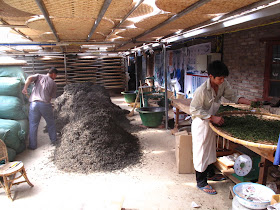 |
| A mountain of maocha |
In the photo below you can see how a large pan of fresh leaves (foreground) is reduced in volume by the process of sha qing (wok-frying to kill-green) to produce mao cha (background).
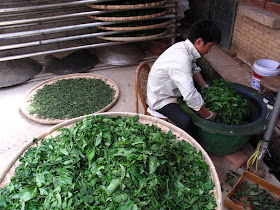 |
| Shaqing puer with electric wok |
I'm not a huge fan of the electric wok. An electric wok produces a more consistent temperature than a wood fire, so less leaves are burnt. As it doesn't produce smoke, the tea won't have the "yan wei" (smoky flavour) that many tea drinkers find off putting. I however, find the electric wok to be artless & cold, and makes me think I am in Hangzhou, not Yunnan. Maintaining a wood fire takes skill, and usually requires a second person dedicated to this task. The wood fire may add smoke, but it also adds charm, crackle & character. The higher risk of burnt or smoky flavors makes good tea produced over a wood fire, even more worthy of appreciation.
After wok-frying, the leaves are scattered over pans for sun drying. You can see the drying racks above the heads of the workers. Sunlight passes through the transparent PVC sheeting, cheaper than glass, but in my opinion, not as good as direct sunlight.
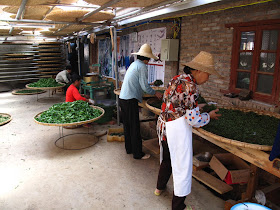 |
| The process of scattering maocha to dry is called "li tiao" |
Some of the tea is lucky enough to be put outside on a tarp where it catches the sun's rays in all their glory. On a good clear day like this, the freshly processed maocha can completely dry in one day, shrivelling up into fragrant black & white twists. If the weather is overcast, it can sometimes require up to 2 days to completely dry. The longer drying period adversely affects the tea's taste, which is why the price of maocha goes up & down according to how many sunny days there are. When it rains, no one makes maocha, and all the producers can do is wait for the sun to come out again.
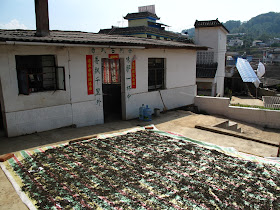 |
| Direct sunlight is the best for drying maocha |
After the maocha is dried, tea sorters have to meticulously pick out all the "huang pian" (old yellow leaves). When picking tea leaves, the farmers will sometimes pick off old leaves to encourage regrowth. Even when picking 1 bud & 3 leaves, it is not uncommon for the 3rd leave to turn into huang pian during the sha qing process. These old leaves need to picked out one by one, and put into a basket. This is strangely meditative work, and it is quite pleasant to spend hours picking out the old crispy leaves. These leaves are not wasted, but sold for as little as RMB 5/kg to make huang pian bricks. Belle and her mum love to boil huang pian - it comes out deliciously sweet. But as gu shu often sells for RMB 500/kg, you can see why some producers are quite happy for the huang pian to be left in!
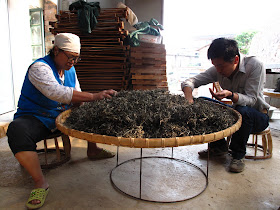 |
| Picking out the "huang pian" (old yellow leaves) |
Next, the maocha should be tossed in pans to separate out the broken leaves, dust & fannings. At Zheng Si Long, this is still done by hand. As this is quite time consuming & back breaking work, I imagine it's only done for gu shu material, and only if the customer is particularly picky, like me.
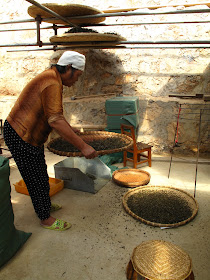 |
| Separating the dust & fannings |
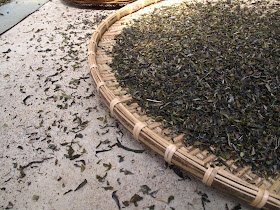 |
| The tea that bites the dust |
Naturally, not all the broken pieces & dust are removed, but it does make for a cleaner tea liquor, and better looking leaves. Just as a lot of whisky evaporates through the cracks in the barrel, I consider this "the angel's share." But in China nothing gets wasted, and I imagine the discarded fannings ends up combined in cheaper "yiwu zheng shan" bings (yiwu mountain, no specified village), or is used in shou pu production. So if you ever detect a whiff of bitter Lao Man E in a sweet Yiwu tea, now you know why ;)
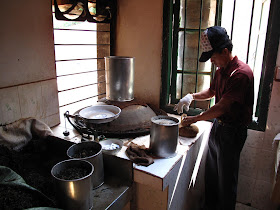 |
| Master of the steam, bag & twist |
I like how Zheng Si Long's employees wear hair nets & gloves. It's a small hygiene factor that reduces the chance of hair ending up in your bing. As you can see the floor is also well swept and the workers are not dripping sweat. The stone presses used by Zheng Si Long are also larger & heavier than those used at other factories. Smaller workshops I visited only use 2 rows of 4 stones. By using 3 rows of 5 presses, the bings are under the stone press for longer. This results in a tighter compression, and slower maturation.
 |
| Stone presses used in Zhen Si Long's puer manufacture |
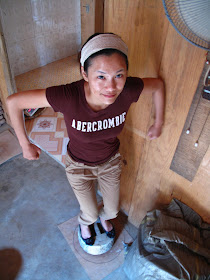 |
| Not all tea is created equal! |
There is a rumour that tea pressed by pretty girls tastes sweeter and deserves to sell at a much higher price. I can confirm that this is definitely true.
The importance of well-used bags cannot be overstated. Good bags are used season after season, until they become tea-stained and resemble delicious pancakes. These bags are well-used because they have passed the test of time, and produce evenly shaped, round bings, with a good, tight, well-packed consistency. Also, I like to think their repeated use imparts the slightest of flavours, from the bag, to the cake, a subtle signature of the factory's quality manufacture & heritage.
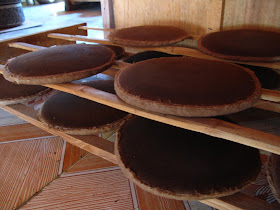 |
| Shade drying Tea Urchin 2011 Spring Lao Man E |
After a period of shade drying, I removed the bags and let them soak up some unadulterated Yiwu sunlight. Even on a beautiful day like this, ours were the only cakes not being put in the drying room or 烤房 "kao fang". I have heard cakes dried in a "kao fang" taste different from those dried in the sun, but have yet to experience this first hand. Personally, it just feels better to know your tea was naturally dried, as tradition & nature intended.
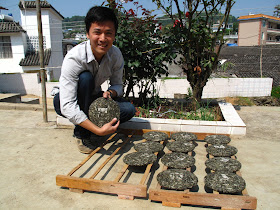 |
| Yep, that's the shit eating grin of a proud new puer parent! |
The Lao Man E leaves are fatter and less stringy than Yiwu leaves, which are known for their long stems. The neifei for this small run were all hand written on hand made paper. Thankfully, the ink did not run during the steaming process.
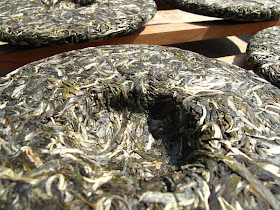 |
| Our Lao Man E cakes sun drying in Yiwu |
Zheng Si Long is a family owned business with a long tradition, and the current head of the family is
郑必能 Zheng Bi Neng. I gave him some of my Lao Man E to try, but as with most people in Yiwu, he believes Yiwu tea is the best drink on earth. He gave me a cake from 2006 to prove it, and signed his name to commemorate our meeting.
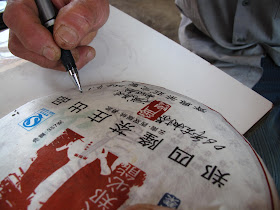 |
| A collectors item, signed by 郑必能 Zheng Bi Neng of Zheng Si Long |
郑必能 Zheng Bi Neng's name roughly translates as "definitely can do!" or "nothing is impossible." I guess his father was not the kind of man to take no for an answer! It is a good way of explaining why he is such a friendly & sincere man, who gives good service to his customers. Next time you drink a Zheng Si Long or Hai Lang Hao, think of Zheng Bi Neng & his family.
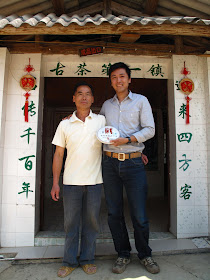 |
| Yours truly with 郑必能 Zheng Bi Neng |
What a nice post, I really enjoy reading your blog, it is fun and educative at the same time :)
ReplyDelete-ER-
You have some incredible and useful blog posts, I have enjoyed reading them all! I just used some 2011 Autumn YiWU Mao Cha in my new Autumn Puer production, It is one of my favorite mountains! Looking forward to more of your travels and post!
ReplyDeleteThanks guys, glad to meet some fellow puer lovers through the interweb!
ReplyDeleteER - your blog is amazing, keep those reviews coming!
Jeffrey - are you blending your own puer? Which regions did you chose to blend together?
Great post!!
ReplyDeleteI really enjoy reading your blog.
Tea Urchin--I am currently blending my own Puer, I love tea very much and have started my company mainly to help educate and build the american Puer tea market. Here is a link to my write up on my first production and the regions I chose. Though it was not until my recent production that I used YiWu Mt MaoCha.
ReplyDeletehttp://www.mcintoshtea.com/updates/2011/1st-production-mcintosh-tea-cake/
I love the up-and-close personal perspective you offer in these posts. Reading about such a small operation definitely makes me want to try some of this tea.
ReplyDeleteI really do like the smoky taste of some teas, including sheng Pu-erh and other Chinese green teas though, and I could relate to what you said about the electric wok. I also imagine that some degree of uneven heating could also produce a greater complexity in the aroma of a tea, much like the uneven oxidation of the leaf in Darjeelings or some larger-leaf white teas contributes to their complexity. Perhaps the sunlight also has such an effect?
Lately I've been realizing how important unevenness or irregularity is at producing high-quality food and drink. For example, when you bake muffins, you don't want to mix them beyond a certain amount, because the heterogeneity of the batter is what creates the wonderful muffin texture.
Really cool to read your story. I am into the high tea and I learned something new about tea. Thanks, Cameron!
ReplyDeleteThanks for your support Alex & Cameron. I've just come out of a long blogging hiatus. It's comments like yours that remind me I do have readers eagerly waiting for new installments!
ReplyDelete